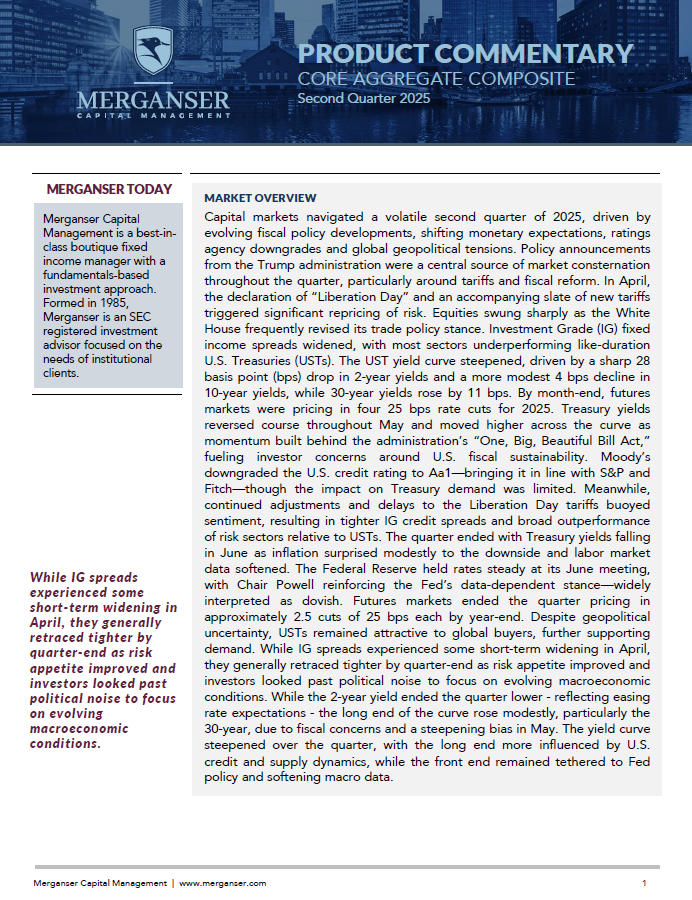MARKET OVERVIEW
Capital markets navigated a volatile second quarter of 2025, driven by evolving fiscal policy developments, shifting monetary expectations, ratings agency downgrades and global geopolitical tensions. Policy announcements from the Trump administration were a central source of market consternation throughout the quarter, particularly around tariffs and fiscal reform. In April, the declaration of “Liberation Day” and an accompanying slate of new tariffs triggered significant repricing of risk. Equities swung sharply as the White House frequently revised its trade policy stance. Investment Grade (IG) fixed income spreads widened, with most sectors underperforming like-duration U.S. Treasuries (USTs). The UST yield curve steepened, driven by a sharp 28 basis point (bps) drop in 2-year yields and a more modest 4 bps decline in 10-year yields, while 30-year yields rose by 11 bps. By month-end, futures markets were pricing in four 25 bps rate cuts for 2025. Treasury yields reversed course throughout May and moved higher across the curve as momentum built behind the administration’s “One, Big, Beautiful Bill Act,” fueling investor concerns around U.S. fiscal sustainability. Moody’s downgraded the U.S. credit rating to Aa1—bringing it in line with S&P and Fitch—though the impact on Treasury demand was limited. Meanwhile, continued adjustments and delays to the Liberation Day tariffs buoyed sentiment, resulting in tighter IG credit spreads and broad outperformance of risk sectors relative to USTs. The quarter ended with Treasury yields falling in June as inflation surprised modestly to the downside and labor market data softened. The Federal Reserve held rates steady at its June meeting, with Chair Powell reinforcing the Fed’s data-dependent stance—widely interpreted as dovish. Futures markets ended the quarter pricing in approximately 2.5 cuts of 25 bps each by year-end. Despite geopolitical uncertainty, USTs remained attractive to global buyers, further supporting demand. While IG spreads experienced some short-term widening in April, they generally retraced tighter by quarter-end as risk appetite improved and investors looked past political noise to focus on evolving macroeconomic conditions. While the 2-year yield ended the quarter lower – reflecting easing rate expectations – the long end of the curve rose modestly, particularly the 30-year, due to fiscal concerns and a steepening bias in May. The yield curve steepened over the quarter, with the long end more influenced by U.S. credit and supply dynamics, while the front end remained tethered to Fed policy and softening macro data.
POSITIONING CHANGES
The second quarter was extremely quiet from an allocation perspective. While the post-Liberation Day volatility was sharp, it proved short-lived. In Short Term Bond portfolios, the team capitalized on attractive pricing in prime auto ABS, but did not find similar opportunities suitable for Core portfolios. The only notable shift in Core was a continued de-risking in non-agency CMBS through the sale of richly valued private label bonds. Broadly, key positioning themes remain in place: significant underweight to longer-duration industrials, an overweight to agency RMBS, and modest overweights to ABS, CMBS, and financials. From an interest rate duration standpoint, we are +/- 5% of the benchmark.
OUTLOOK
The worst-case scenario for global trade seems to be off the table but there remain more questions than answers on trade and immigration policy. Housing seems to be at an inflection point which will have negative multiplier effects at best, and significant impacts (certainly less than the last time around) at worst. The economy has been able to shake off these concerns with a low 4.2% unemployment rate with positive but softening job growth. The US involvement in the Middle East is likely to increase energy price volatility as supply shocks to the positive (OPEC+ supply hikes) and negative (disruptions to key transportation/production sites) attempt to balance the market. In June, Fed Chair Powell noted the continued strength of the economy while signaling they are willing and able to lower rates when appropriate. The Fed’s latest inflation forecasts estimate 3% for 2025 and 2.4% for 2026. That would be six years of above-target inflation, leaving them understandably reticent to cut while waiting for clarity on the impact of trade policy. Still, they are expecting two 25 basis point rate cuts this year, while futures markets predict between two and three (as of 6/30/2025). Volatility at the long end of the curve has been dramatic, with a nearly 100 basis point range for the 10-year since the first Fed cut in September. The front end of the curve continues to track with expectations of Fed cuts in the future. Recent data shows continued progress toward the Fed’s elusive 2% goal. University of Michigan 1-year expectations came in at 5.1%, much softer than expected (6.4%) but longer term 5–10-year expectations remain elevated at 4.1%.
Corporate Credit spreads, while comfortably above the lows for this cycle, remain historically expensive. Heightened concerns about geopolitical risks have not materially impacted spreads. The eased regulatory backdrop has led to a blitz of M&A activity, pressuring future industrial balance sheets, but setting up a strong 2025 for money center banks. We continue to prefer shorter exposures and remain circumspect when it comes to Tech, Pharma/Healthcare, Retail and Autos. Agency Mortgage spreads currently provide modest incremental value on a risk adjusted basis versus other spread sectors. Despite the recent rally in 10-year Treasury yields, 30-year mortgage rates remain sticky, leaving much of the universe out-of-the-money. While we view this government guaranteed sector as providing a reasonable rate of return and exceptional liquidity, we don’t see a catalyst for spread tightening in the near term. While most consumer credit strata are showing signs of weakness, the relative weakness varies dramatically between prime and subprime. Collateral performance in prime receivables continues to show a modest increase in delinquencies. Many subprime shelves and unsecured consumer loans have deteriorated noticeably and bear watching. We are avoiding the subprime market entirely and focusing on the highest quality consumer and commercial related collateral. CMBS continues to move towards a SASB market. There are benefits (targeted exposures, increased transparency, generally lower duration) but it adds idiosyncratic risks in an already idiosyncratic sector. Spreads have recovered from their brief Liberation Day widening and we are open to selectively participating in new deals on swap, i.e. not raise exposure. Fundamentals will follow the labor market which we see as slowing; but note that even in a strong labor market, delinquencies have been rising back to early Covid levels as refinance activity remains challenging, and modifications eventually face a reckoning.


